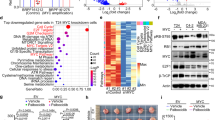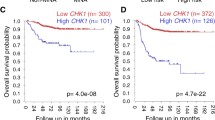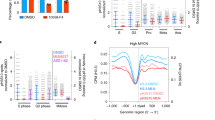Abstract
Tumor cells have a dysregulated cell cycle that may render their proliferation especially sensitive to the inhibition of cyclin-dependent kinases (CDKs), important regulators of cell cycle progression. We examined the effects of CDK1 inhibition in the context of different oncogenic signals. Cells transformed with MYC, but not cells transformed by a panel of other activated oncogenes, rapidly underwent apoptosis when treated with small-molecule CDK1 inhibitors. The inhibitor of apoptosis protein BIRC5 (survivin), a known CDK1 target, is required for the survival of cells overexpressing MYC. Inhibition of CDK1 rapidly downregulates survivin expression and induces MYC-dependent apoptosis. CDK1 inhibitor treatment of MYC-dependent mouse lymphoma and hepatoblastoma tumors decreased tumor growth and prolonged their survival. As there are no effective small-molecule inhibitors that selectively target the MYC pathway, we propose that CDK1 inhibition might therefore be useful in the treatment of human malignancies that overexpress MYC.
This is a preview of subscription content, access via your institution
Access options
Subscribe to this journal
Receive 12 print issues and online access
$209.00 per year
only $17.42 per issue
Buy this article
- Purchase on Springer Link
- Instant access to full article PDF
Prices may be subject to local taxes which are calculated during checkout






Similar content being viewed by others
References
Morgan, D.O. The Cell Cycle: Principles of Control (New Science Press, London, 2007).
Th'ng, J.P. et al. The FT210 cell line is a mouse G2 phase mutant with a temperature-sensitive CDC2 gene product. Cell 63, 313–324 (1990).
Itzhaki, J.E., Gilbert, C.S. & Porter, A.C. Construction by gene targeting in human cells of a 'conditional' CDC2 mutant that rereplicates its DNA. Nat. Genet. 15, 258–265 (1997).
Morgan, D.O. Cyclin-dependent kinases: engines, clocks, and microprocessors. Annu. Rev. Cell Dev. Biol. 13, 261–291 (1997).
Gray, N.S. et al. Exploiting chemical libraries, structure, and genomics in the search for kinase inhibitors. Science 281, 533–538 (1998).
O'Connor, D.S. et al. Regulation of apoptosis at cell division by p34cdc2 phosphorylation of survivin. Proc. Natl. Acad. Sci. USA 97, 13103–13107 (2000).
Jiang, X.R. et al. Telomerase expression in human somatic cells does not induce changes associated with a transformed phenotype. Nat. Genet. 21, 111–114 (1999).
Van Roy, F.M. et al. Invasiveness and metastatic capability of rat fibroblast-like cells before and after transfection with immortalizing and transforming genes. Cancer Res. 46, 4787–4795 (1986).
Klefstrom, J., Verschuren, E.W. & Evan, G. c-Myc augments the apoptotic activity of cytosolic death receptor signaling proteins by engaging the mitochondrial apoptotic pathway. J. Biol. Chem. 277, 43224–43232 (2002).
Juin, P., Hueber, A.O., Littlewood, T. & Evan, G. c-Myc-induced sensitization to apoptosis is mediated through cytochrome c release. Genes Dev. 13, 1367–1381 (1999).
Davenport, E.A., Drobes, B.L., Menke, S.L., Vaidya, T.B. & Taparowsky, E.J. Cooperation of oncogenes in the multistep transformation of established fibroblasts in culture. Anticancer Res. 8, 959–969 (1988).
Eischen, C.M., Weber, J.D., Roussel, M.F., Sherr, C.J. & Cleveland, J.L. Disruption of the ARF-Mdm2-p53 tumor suppressor pathway in Myc-induced lymphomagenesis. Genes Dev. 13, 2658–2669 (1999).
Zindy, F. et al. Myc signaling via the ARF tumor suppressor regulates p53-dependent apoptosis and immortalization. Genes Dev. 12, 2424–2433 (1998).
Little, C.D., Nau, M.M., Carney, D.N., Gazdar, A.F. & Minna, J.D. Amplification and expression of the c-myc oncogene in human lung cancer cell lines. Nature 306, 194–196 (1983).
Hollis, G.F., Gazdar, A.F., Bertness, V. & Kirsch, I.R. Complex translocation disrupts c-myc regulation in a human plasma cell myeloma. Mol. Cell. Biol. 8, 124–129 (1988).
Mineo, C., Murakami, Y., Ishimi, Y., Hanaoka, F. & Yamada, M. Isolation and analysis of a mammalian temperature-sensitive mutant defective in G2 functions. Exp. Cell Res. 167, 53–62 (1986).
Adams, J.M. et al. The c-myc oncogene driven by immunoglobulin enhancers induces lymphoid malignancy in transgenic mice. Nature 318, 533–538 (1985).
Shachaf, C.M. et al. MYC inactivation uncovers pluripotent differentiation and tumour dormancy in hepatocellular cancer. Nature 431, 1112–1117 (2004).
Green, D.R. & Evan, G.I. A matter of life and death. Cancer Cell 1, 19–30 (2002).
Deveraux, Q.L. et al. IAPs block apoptotic events induced by caspase-8 and cytochrome c by direct inhibition of distinct caspases. EMBO J. 17, 2215–2223 (1998).
Roy, N., Deveraux, Q.L., Takahashi, R., Salvesen, G.S. & Reed, J.C. The c-IAP-1 and c-IAP-2 proteins are direct inhibitors of specific caspases. EMBO J. 16, 6914–6925 (1997).
Mesri, M., Wall, N.R., Li, J., Kim, R.W. & Altieri, D.C. Cancer gene therapy using a survivin mutant adenovirus. J. Clin. Invest. 108, 981–990 (2001).
Beltrami, E., Plescia, J., Wilkinson, J.C., Duckett, C.S. & Altieri, D.C. Acute ablation of survivin uncovers p53-dependent mitotic checkpoint functions and control of mitochondrial apoptosis. J. Biol. Chem. 279, 2077–2084 (2004).
Mateyak, M.K., Obaya, A.J. & Sedivy, J.M. c-Myc regulates cyclin D-Cdk4 and -Cdk6 activity but affects cell cycle progression at multiple independent points. Mol. Cell. Biol. 19, 4672–4683 (1999).
Beier, R. et al. Induction of cyclin E-cdk2 kinase activity, E2F-dependent transcription and cell growth by Myc are genetically separable events. EMBO J. 19, 5813–5823 (2000).
Schuldiner, O. & Benvenisty, N.A. DNA microarray screen for genes involved in c-MYC and N-MYC oncogenesis in human tumors. Oncogene 20, 4984–4994 (2001).
Swarbrick, A. et al. Regulation of cyclin expression and cell cycle progression in breast epithelial cells by the helix-loop-helix protein Id1. Oncogene 24, 381–389 (2005).
Afar, D.E., Goga, A., McLaughlin, J., Witte, O.N. & Sawyers, C.L. Differential complementation of Bcr-Abl point mutants with c-Myc. Science 264, 424–426 (1994).
Sofer-Levi, Y. & Resnitzky, D. Apoptosis induced by ectopic expression of cyclin D1 but not cyclin E. Oncogene 13, 2431–2437 (1996).
Shan, B., Farmer, A.A. & Lee, W.H. The molecular basis of E2F–1/DP-1-induced S-phase entry and apoptosis. Cell Growth Differ. 7, 689–697 (1996).
Nesbit, C.E., Grove, L.E., Yin, X. & Prochownik, E.V. Differential apoptotic behaviors of c-myc, N-myc, and L-myc oncoproteins. Cell Growth Differ. 9, 731–741 (1998).
Adachi, S. et al. c-Myc is necessary for DNA damage-induced apoptosis in the G(2) phase of the cell cycle. Mol. Cell. Biol. 21, 4929–4937 (2001).
O'Connor, D.S., Wall, N.R., Porter, A.C. & Altieri, D.C. A p34(cdc2) survival checkpoint in cancer. Cancer Cell 2, 43–54 (2002).
Altieri, D.C. The case for survivin as a regulator of microtubule dynamics and cell-death decisions. Curr. Opin. Cell Biol. 18, 609–615 (2006).
Blanc-Brude, O.P. et al. Therapeutic targeting of the survivin pathway in cancer: initiation of mitochondrial apoptosis and suppression of tumor-associated angiogenesis. Clin. Cancer Res. 9, 2683–2692 (2003).
Plescia, J. et al. Rational design of shepherdin, a novel anticancer agent. Cancer Cell 7, 457–468 (2005).
Bild, A.H. et al. Oncogenic pathway signatures in human cancers as a guide to targeted therapies. Nature 439, 353–357 (2006).
Pear, W.S., Nolan, G.P., Scott, M.L. & Baltimore, D. Production of high-titer helper-free retroviruses by transient transfection. Proc. Natl. Acad. Sci. USA 90, 8392–8396 (1993).
Eilers, M., Picard, D., Yamamoto, K.R. & Bishop, J.M. Chimaeras of myc oncoprotein and steroid receptors cause hormone-dependent transformation of cells. Nature 340, 66–68 (1989).
Hirose, Y., Berger, M.S. & Pieper, R.O. Abrogation of the Chk1-mediated G2 checkpoint pathway potentiates temozolomide-induced toxicity in a p53-independent manner in human glioblastoma cells. Cancer Res. 61, 5843–5849 (2001).
Felsher, D.W. & Bishop, J.M. Reversible tumorigenesis by MYC in hematopoietic lineages. Mol. Cell 4, 199–207 (1999).
Yang, D., Welm, A. & Bishop, J.M. Cell division and cell survival in the absence of survivin. Proc. Natl. Acad. Sci. USA 101, 15100–15105 (2004).
Acknowledgements
We thank N. Gray (Scripps Institute) for CDK inhibitors and helpful discussion, R. Longnecker (Northwestern Univ.) for the ES1 cell line and L. Urisman for excellent technical support. We thank G. Evan, K. Shannon, D. Donner and members of the Bishop and Morgan labs for helpful discussions. We thank the following for providing us with retroviral constructs: J. DeGregori (Univ. of Colorado) for E2F1 and E2F3, Y. Refaeli (National Jewish Medical and Research Center) for Myr-AKT and BCL2, O. Tetsu (Univ. California, San Francisco) for CCND1, O. Witte (Univ. California, Los Angeles) for BCR/ABL, and A. Capobianco (Univ. Pennsylvania) for Notch1-IC(ΔPest). We thank the University of California, San Francisco Liver Center (P30 DK26743) for procurement of normal mouse hepatocytes. This work was supported by a Howard Hughes Medical Institute Physician-Scientist Fellowship and US National Institutes of Health (NIH) K08 CA104032 (A.G.), The Susan G. Komen Breast Cancer Research Fund (D.Y.), NIH Medical Scientist Training Program (A.T.), NIH R01 GM69901 (D.M.) and the UCSF G.W. Hooper Research Foundation (J.M.B.).
Author information
Authors and Affiliations
Contributions
A.G. performed cell culture, biochemical experiments and histological analysis. A.G. and A.T. performed animal experiments. D.Y. performed siRNA experiments. A.G., D.O.M. and J.M.B. carried out experimental design, data analysis and manuscript preparation.
Corresponding author
Ethics declarations
Competing interests
The authors declare no competing financial interests.
Supplementary information
Supplementary Fig. 1
Preferential induction of apoptosis in MYC over-expressing RPE cells. (PDF 31 kb)
Supplementary Fig. 2
A MYC-dependent mouse liver cancer model. (PDF 390 kb)
Supplementary Fig. 3
Expression of oncogenes in Rat1 fibroblasts. (PDF 53 kb)
Rights and permissions
About this article
Cite this article
Goga, A., Yang, D., Tward, A. et al. Inhibition of CDK1 as a potential therapy for tumors over-expressing MYC. Nat Med 13, 820–827 (2007). https://doi.org/10.1038/nm1606
Received:
Accepted:
Published:
Issue Date:
DOI: https://doi.org/10.1038/nm1606
This article is cited by
-
Multi-region sampling with paired sample sequencing analyses reveals sub-groups of patients with novel patient-specific dysregulation in Hepatocellular Carcinoma
BMC Cancer (2023)
-
Alternative approaches to target Myc for cancer treatment
Signal Transduction and Targeted Therapy (2021)
-
The SUMO pathway in pancreatic cancer: insights and inhibition
British Journal of Cancer (2021)
-
Directly targeting c-Myc contributes to the anti-multiple myeloma effect of anlotinib
Cell Death & Disease (2021)
-
Identification of potential key genes and miRNAs involved in Hepatoblastoma pathogenesis and prognosis
Journal of Cell Communication and Signaling (2021)



